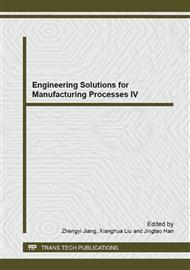p.869
p.875
p.881
p.886
p.893
p.897
p.902
p.906
p.911
Design of a Giant Magnetostrictive Actuator and Research on the Effect of Water Cooling System
Abstract:
Actuators made of giant magnetostrictive materials (GMM) have good application prospect in the precise driving. Because characteristics of GMM are very sensitive to temperature, the coil thermal effect will cause phenomenon of heat expansion and cold contraction in GMM, which affects the precise displacement output of the actuator. Coil skeleton and water cooling system are installed between the coil and the GMM rod in this design. The effect of water cooling system on the coil temperature rise is experimental studied. It is found that water cooling system can effectively reduce the influence of the coil temperature rise on displacement output of the GMM rod. Water cooling system has greatly improved the coil operating temperature when current is low, while cooling effect is not big for the larger current. That is because the coil heating is strong and the water can not immediately take away the heat. But coil temperature rise is still limited in allowable range. Thus, experiment results show that water cooling system can effectively ensure output precision of the GMM actuator.
Info:
Periodical:
Pages:
893-896
Citation:
Online since:
February 2014
Authors:
Price:
Сopyright:
© 2014 Trans Tech Publications Ltd. All Rights Reserved
Share:
Citation:


